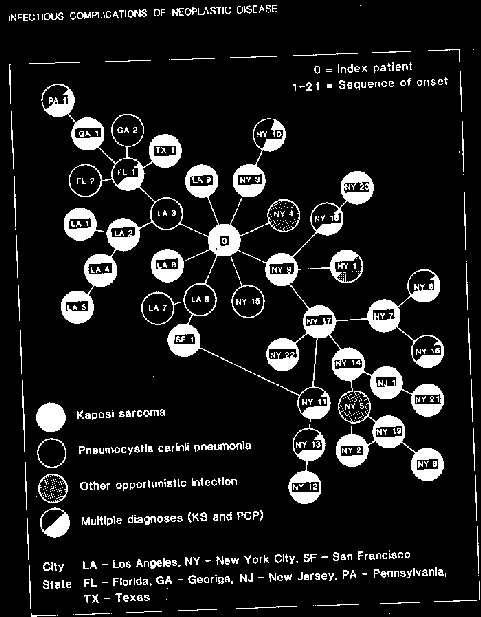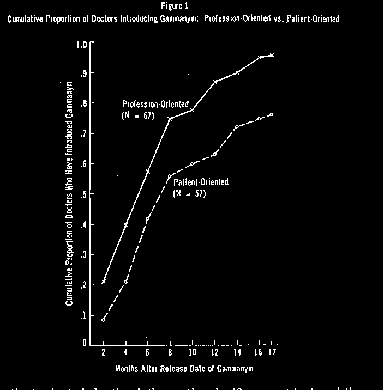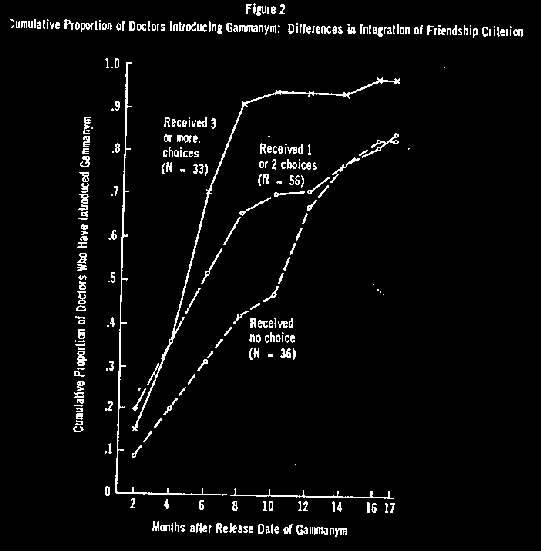
Diffusion refers to the spread of something, such as a story or an infection, through a population. One way this can happen is through simultaneous invention: lot’s of people simply come to the same conclusion at about the same time (e.g., many companies seem to have decided independently that it is important to have a web site on the internet). One way things can diffuse is through some kind of broadcasting — such as a radio station broadcasting the news. Another way it occurs is via word-of-mouth: person to person transmission.
An interesting example of diffusion is the spread of rumors or gossip. We consider that topic in detail later in the semester.
Another kind of diffusion is that of a viral infection, such as HIV. When AIDS was first coming to light, researchers had no knowledge what was causing it. In fact, it took a long time to figure out it was a thing, rather than unrelated cases. What doctors actually observed was that rare diseases like Kaposi’s Sarcoma, which is a kind of cancer, and certain types of pneumonia were popping up in various places. They began to suspect that the different diseases might be related — all caused by an underlying disease that weakened the immune system.
But it wasn’t until they started asking the patients, who were spread out all over the country, if they knew any of the other patients. It happened that some did, which is a big coincidence in a country of 260 million. But lots of people knew these patients and they weren’t patients themselves. Well, after some digging it turned out that some of the patients had had sex with some of the other patients (before they became sick, that is). Bill Darrow of the CDC started systematically asking AIDS patients to name their sexual partners, then contacted them, and so forth. There turned out to be a clear pattern: about a year after having sex with someone who later developed AIDS, many people developed AIDS.
Here is a picture of the sexual relations among patients only (compare it in your mind to a picture of sexual relations among all people in the US who currently have a broken arm: you don’t expect more than a tiny tiny fraction to have had sex with each other).

You can see in the picture that every patient had had sex with at least one other patient. Also, the time of symptom onset is similar for people who had sex with each other. So that people who developed the disease later are people who had sex with people who had the disease later.
Adoption of Innovation
A special kind of diffusion is the adoption of innovations. To adopt an innovation means to acquire a new product or behavior. For example, it used to be that in America people believed that tomatoes were poisonous and wouldn’t eat them. Eventually, though, through immigrants, people started eating them. Similarly, people all over the world are buying personal computers, something that essentially did not exist before the 1980s.
One adoption that was studied by Coleman, Katz and Menzel in the ‘50s was the adoption by physicians of the new drug tetracycline. They collected data 15 months after the drug was released. They interviewed 85% of all physicians in 4 small midwestern cities. The dependent variable (what they were trying to explain) was time of adoption (when the doctors first started prescribing tetracycline).
The first thing they looked at was attributes of the physicians, such as their age, their education, their professional orientations (e.g., patient-oriented vs research-oriented). Many of these things made a difference. For example, the more professionally-oriented (vs. Patient oriented) a doctor was, the more likely they were to prescribe tetracycline, as shown in the figure.

But what also mattered was whether the doctors had a lot of friends and people whom they gave advice to. See next figure:

It seems like the more embedded into the physician social network they were, the more likely they were to adopt the drug and do it early. But you might ask whether it couldn’t be that some third variable was responsible for both. For example, maybe some people are just smarter than others, and this both makes them popular (network-embedded) and makes them adopt the new drug faster.
But there is other reason to believe there really is a network effect. Notice that in the graph comparing physician orientations, the top curve is always above the bottom curve, as it should be if one orientation makes you more likely to adopt than other. But in the second graph, the more network embedded doctors are not always above the other doctors. They actually start at the same place. But the adoption curve for the embedded doctors is much steeper. This is consistent with a network effect where one doctor persuades his friends, who then persuade their friends, etc. which creates an exponential growth process.
| Time | New Adopters | Cumulative Number |
1 |
1 |
1 |
2 |
3 |
4 |
3 |
9 |
13 |
4 |
27 |
40 |
5 |
81 |
121 |
6 |
243 |
364 |
7 |
729 |
1093 |
8 |
2187 |
3280 |
9 |
6561 |
9841 |
10 |
19683 |
29524 |
11 |
59049 |
88573 |
12 |
177147 |
265720 |
13 |
531441 |
797161 |
14 |
1594323 |
2391484 |